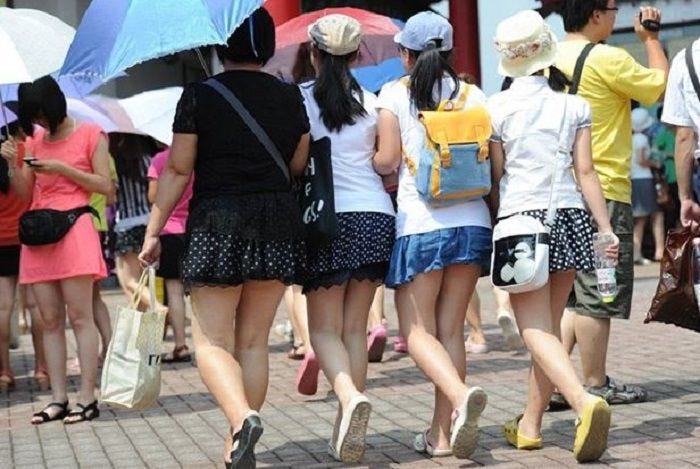China’s leaders have known for some time that they have a demographics problem, with their concern growing at the threat to future prosperity and dynamism. The population decline is set to accelerate, with China’s male-female imbalance presenting limiting factors not faced by the rest of Asia.
The median age is already 40.2, nearly the same as older developed countries such as the UK (40.8) and higher than the United States at 38.5. China’s fertility rate appears to be about 1.1, or half the population replacement level.
Various programs in China, as in other countries such as South Korea with similar challenges, are focused on issues such as financial support for children, greater equality in the workplace, provision of nursery facilities, etc. Such incentives make sense but so far have had limited success in other countries. They may yet have an impact in China – though it is rather more difficult to force couples to have more children than it was to limit them to one child, as was the case with the One Child policy introduced in 1979 and only formally abandoned in 2015.
But compared with other countries facing the same birth collapse, China’s prospects for raising the fertility rate face a major additional obstacle, the imbalance between numbers of men and women of the childbearing age bracket. This is the indirect consequence of One Child – a deep-rooted patriarchal bias towards male children which led to widespread abortion of female foetuses. This is not just a product of the past. Although the imbalance of sexes at birth has narrowed, there is still a significant gap.
This year, according to UN World Population Prospects 2024, there are 44.4 million men in the 25-29 age group, which should be on the cusp of procreation, but only 38.4 million women. The gap in absolute terms diminishes with the subsequent cohorts but remains in double-digit percentages.
Age 20-24 - 42.5 million men; 36.3 million women
Age 15-19 - 45.6 million men; 38.9 million women
Age 10-14 - 48.5 million men; 41.8 million women
Age 5-9 - 42.7 million men; 37.5 million women
Age 0-4 - 24.9 million men; 22.5 million women
The data thus shows the very sharp decline in overall births and the continuation of imbalance. In other words, even if the authorities have some success in raising the fertility rate (number of births per woman) the number of births will be held back by the ongoing sex imbalance.
China, like most countries, has also been seeing a trend toward later marriage. By 2021, the average birthing age for women had reached 28.8 years and was rising. It is probably now about 30 years, less than Hong Kong and South Korea, now at 32, and Europe in the 30-32 range, but may well continue to rise to their levels.
This trend is a further limit on total births. So too is women’s fairly high (60 percent) workforce participation rate. In parts of Europe, this is partly offset by nursery and other support measures and assumptions that males play a larger role in looking after the very young. That will probably come in China but maybe not while the Politburo is, as now, 100 percent male and the male birth bias continues. While the steep decline in the 0-4 cohorts compared with 5-9 may be attributed to Covid, there is scant sign of a sustained recovery in total births, nor of elimination in the imbalance. Nature has always provided a small surplus of male births – globally, a ratio of about 104 to 100 – because of higher early death rates of boys. But China’s remains well above the natural rate by about 5 percent.
The Chinese Communist Party finds it difficult to admit and confront the disasters – the One Child policy, the Great Leap Forward, the Proletarian Cultural Revolution – that it has inflicted on the country. Until it does, it may merely tinker with a demographic challenge which has already been set in stone for 30-plus years. By 2050, there will be only about 720 million in the 15-64 age bracket compared with 976 million today and their average age will be much higher.
Unless automation and AI come to the rescue, the demographics could lead to increased demand for female labor, further holding back maternity. Meanwhile, India’s 15-64 working age group is set to surpass 1 billion.
China’s situation is, of course, far from unique. Hong Kong, Singapore, South Korea, and Taiwan all have similar fertility rates, with Singapore vainly seeking to solve its problem for four decades. But among large countries, China stands out for its gender imbalance, which exacerbates the problem. India has had a similar problem, but its ratio of male births has declined from 109 to 105 between 2004 and 2024. In India, the imbalance also varies greatly by region.
Of course, social attitudes in China, as well as government policies, can change remarkably quickly, but any such change takes two decades or more to alter the demographic fundamentals. And no country so far has been able to solve the falling birth rate problem except by immigration of working-age migrants.



I am making a good salary from home $4580-$5240/week , which is amazing under a year ago I was jobless in a horrible economy. I thank God every day I was blessed with these instructions and now its my duty to pay it forward and share it with Everyone,
Here is I started_______ LIVEJOB1.COM
Importing working age migrants to solve this problem will not solve it as it makes the male female balance even worse.